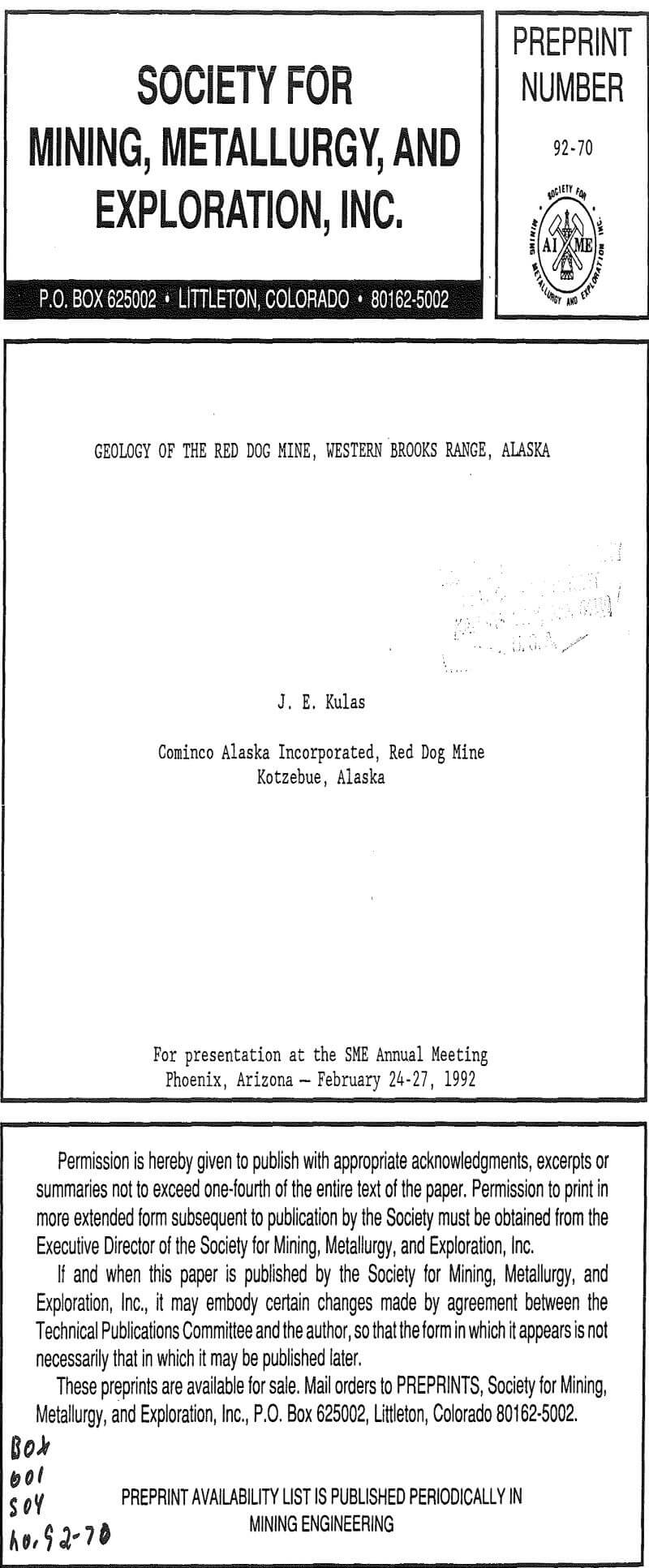Table of Contents
Red Dog is a Mississippian to Permian aged sulfide deposit located in the western Brooks Range north of Kotzebue, Alaska. It belongs in the family of black shale hosted sedimentary exhalite deposits but lacks classic sulfide sedimentary textures. Pervasive silicification, and a significant portion of the mineralization, is replacement in nature. An extensive feeder vein system cuts the footwall and the exhalite package. A Jurassic to Cretaceous age compressional event has repeated the ore section through thrust faulting and folding. The orebody contains 77,000,000 metric tons averaging 17.1% Zn, 5.0% Pb and 82 g per metric ton of Ag. Weathering has locally altered the sulfides to sulfates and formed elemental sulfur.
The Operation
An open pit is used with an expected annual production of 1,506,088 metric tons of ore per year. The overall strip ratio is 0.9 to 1.0 waste to ore.
Benches are 7.6m high with pit slopes of 1 to l in ore decreasing to 2 to 1 in waste. Expansion of the pit will ultimately require the diverting of Red Dog Creek.
Because of the high grade and low stripping ratio the mine’s tonnages and the equipment fleet are relatively small. Two Driltech D40K blast hole drills are used for drilling 21.6 cm blast holes. One of these drills has been used as a reverse circulation drill for infill development drilling. Haulage is accomplished with four, 77 metric ton, Caterpillar 777 trucks that are loaded with a 10 m³ Caterpillar 992 loader (three are available).
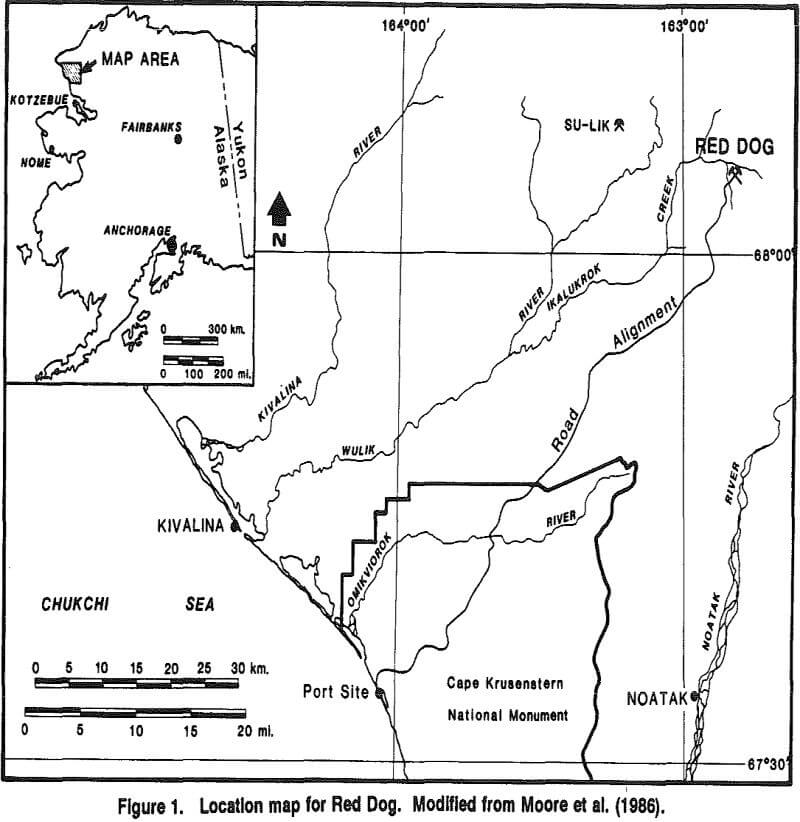
Because of the fine grind size and presence of zinc sulfate in the feed, an abnormally large, 61 m in diameter mill feed thickener is used. It insures adequate retention time which provides proper density for flotation and removes soluble zinc from the feed. Lead flotation and subsequent zinc flotation is handled by a battery of tank cells and column cells. Dewatering is accomplished with four 84 chamber pressure filters.
Geology
Two separate but related mineral deposits occur at Red Dog; the Main Deposit and the Hilltop Deposit. Originally part of the same ancestral orebody they are now separated by a distance of 762 m. T
The Main Deposit is the area of current mining and contains the Red Dog reserve. The orebody is an elongated zone 1,524 m long and 460 m wide with a long axis trending about N30W. Maximum ore thickness is 152 m, including internal waste. Its shape
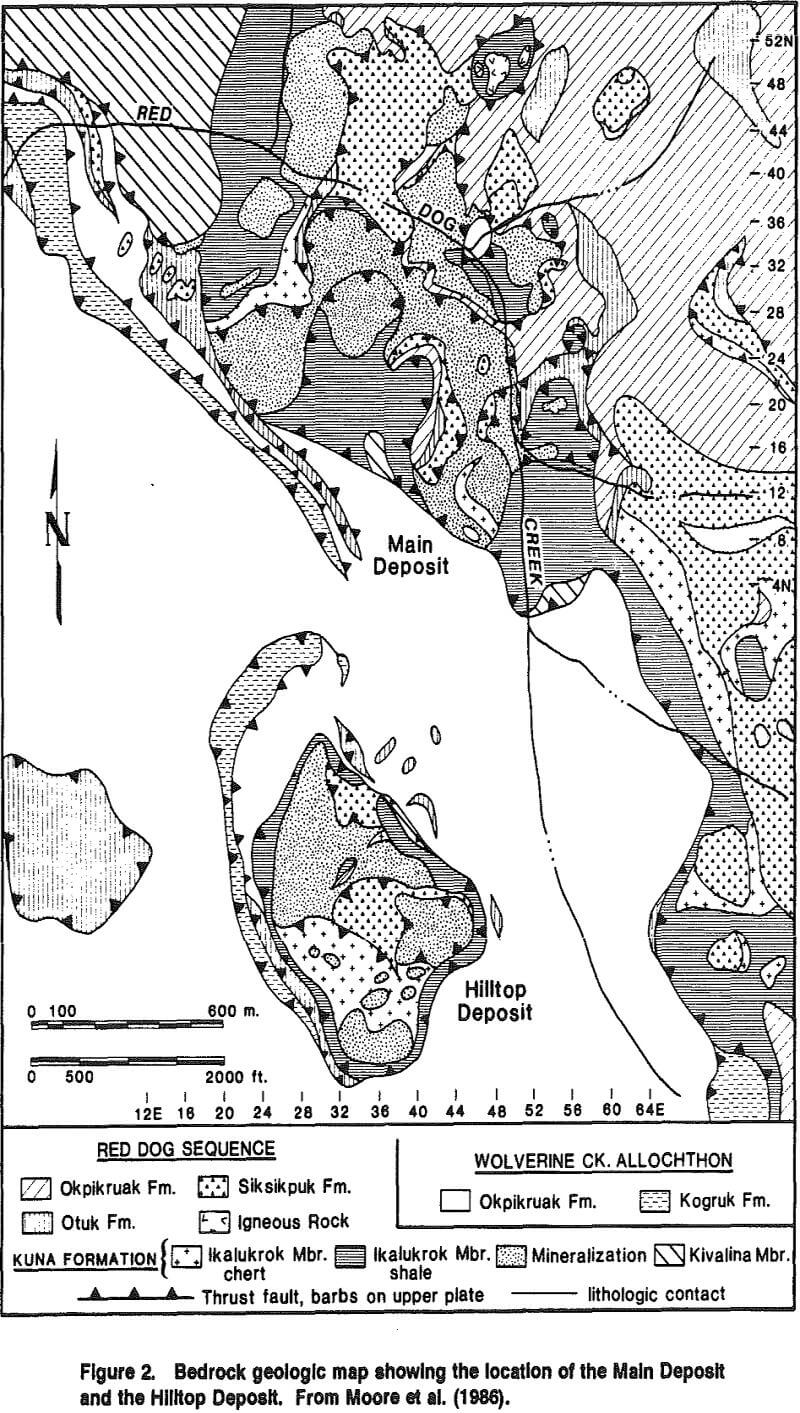
Located south of the Main Deposit, the Hilltop Deposit has similar but less understood geology. The mineralized zone is currently identified to be 490 m long and 245 m wide and is contained in two flat lying thrust plates. The entire exhalite package is less than 100 m thick. Twenty core holes have been drilled in Hilltop for a total of 1,368 m.
Red Dog lies near the base of a regionally repeated package of Devonian to Cretaceous rocks. This allochthonous sequence represents portions of a basin that was passively thrust northward into their present position. Red Dog and similar base metal occurrences in the region are hosted in the Mississippian to Pennsylvanian Kuna Formation shale of the Brooks Range allochthon, the second from the bottom in the allochthonous sequence.
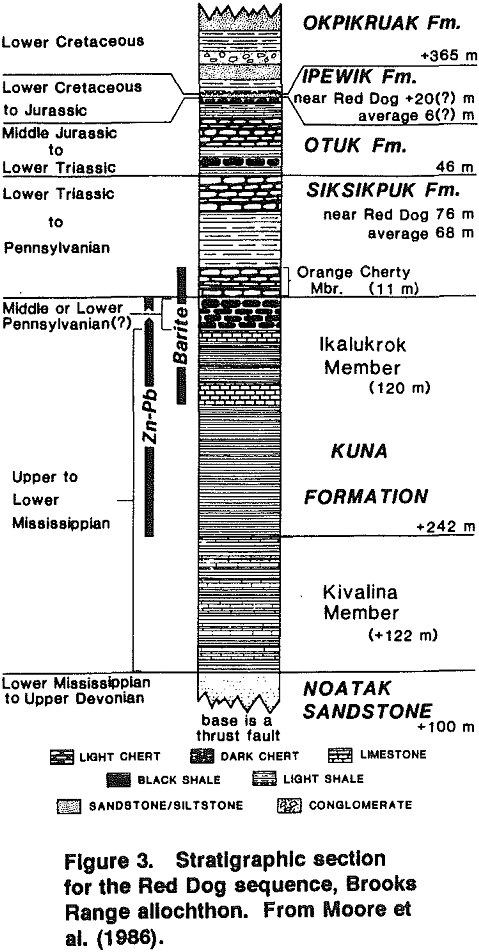
All rocks associated with the mineralizing event, including silicified Ikalukrok Formation and unmineralized barite rock in the Siksikpuk Formation, are included in the exhalite rock suite. Three rock types dominate and form a gradational continuum. They are silica rock, barite rock and sulfide rock. The exhalite mineralogy is simple and primarily limited to quartz, barite, sphalerite, galena, pyrite and marcasite. The exhalite suite is hosted primarily in the Ikalukrok member, but ranges from the Upper Kivalina member to Middle Siksikpuk Formation.
Barite Rock: Two types of barite rock exist, mineralized and unmineralized.
Mineralized barite rock is hosted by the Ikalukrok Member of the Kuna Formation and is the more prevalent of the two types. It is commonly dark gray, fine to medium crystalline, non- orientated aggregates of prismatic crystals with variable amounts of interstitial sulfides. Barite rock is often ore grade and has a higher Pb to Zn ratio than the rest of the orebody. Silicification of barite rock is observed. Worm tubes/ burrows occur in Ikalukrok barite rock.
Sulfide Rock: Exhalite rock with greater than forty percent total sulfides is classified as sulfide rock. Sulfide rock is further subdivided into semi-massive sulfide rock (40 to 70% total sulfides) and massive sulfide rock (>70% total sulfides). Silica is the main gangue mineral, lesser amounts of barite is also common. Sulfide rock grades into silica rock and is also in a continuum with Ikalukrok barite rock.
Ore textures range from massive to disrupted and fragmental. Laminated and bedded textures common to syngenetic sulfide deposition, and characteristic of “classic” sedex deposits and other black shale hosted base metals in the region (e.g. the Lik Deposit), are rarely observed at Red Dog. The disrupted textures can be interpreted, in part, by soft sediment deformation. However, petrographic work indicates a significant portion of the sulfides are formed by replacement, not sulfide sedimentation.
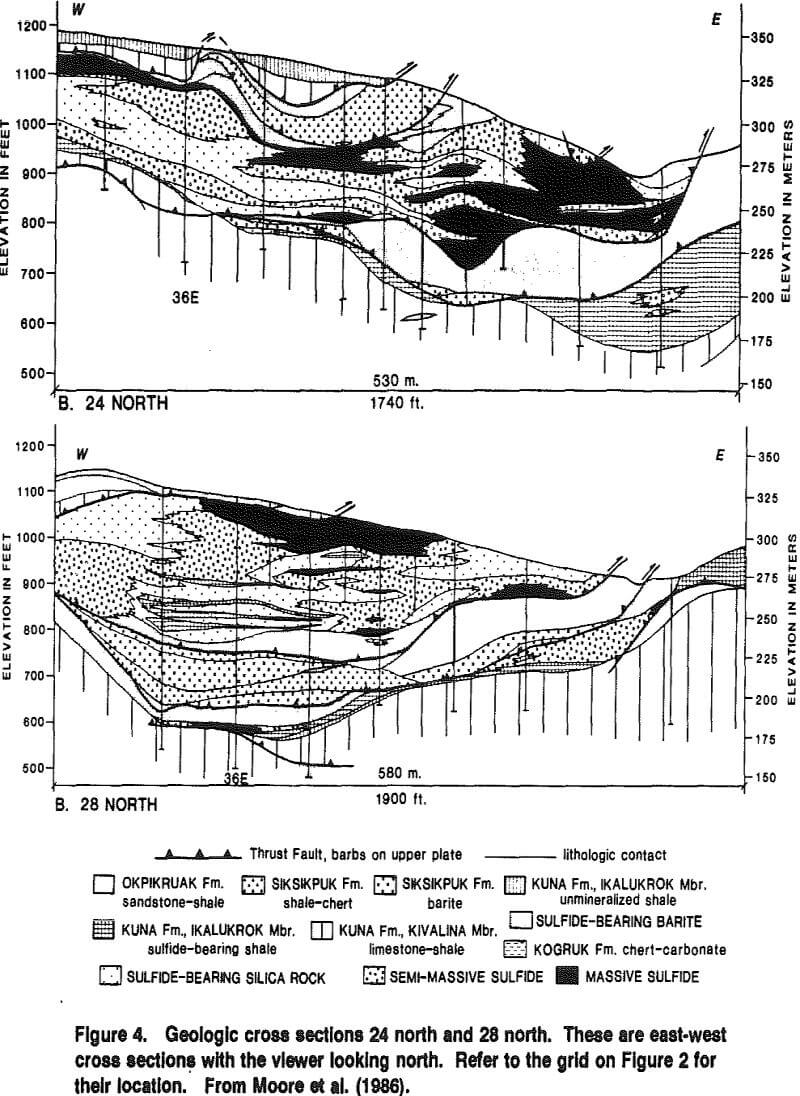
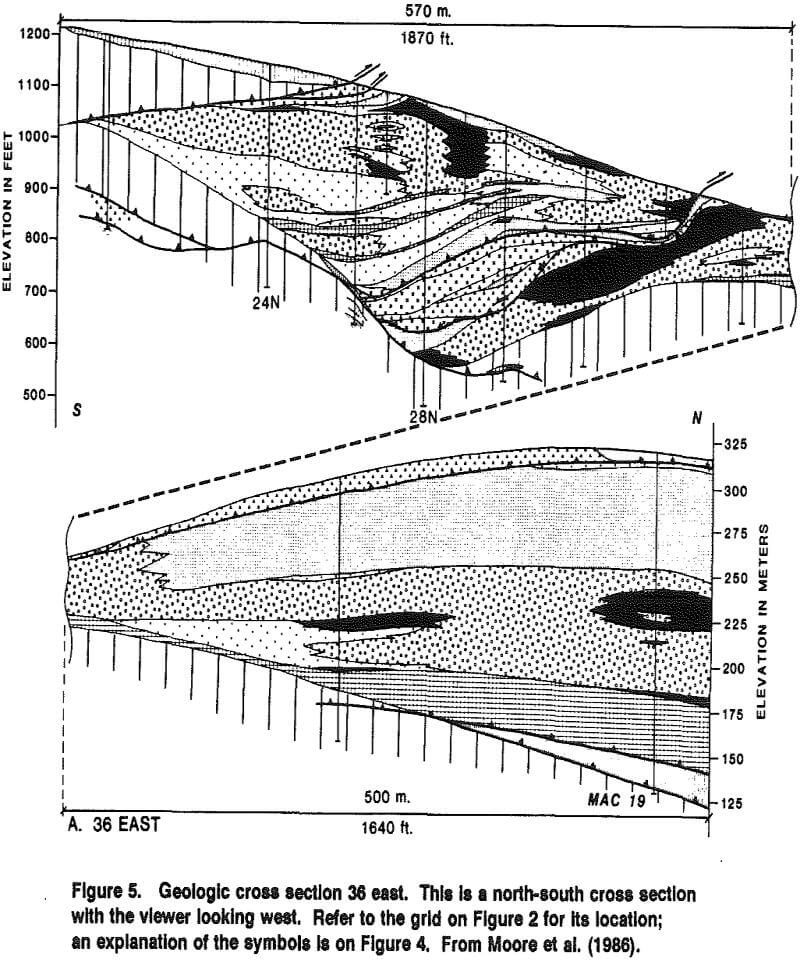
Weathering
The upper portion of the Red Dog orebody has been weathered by oxidizing conditions. The contact between
weathered rock and unweathered rock is very irregular and can be abrupt to gradational over several meters. The weathered zone averages 6 m thick and ranges from less than a meter thick up to 20 m thick. Increased porosity due to fracturing appears to be an important control for the localization of weathering.
Physically the weathered material ranges from competent rock to soft poorly cohesive rock to disaggregated sand and clay. Weathered ore can contain either sulfides and/or sulfates. Weathering intense enough to produce totally disaggregated sulfide “sand” may not necessarily produce appreciable amounts of sulfates. Oxidation alters sphalerite to zinc melanterite and pyrite to melanterite. Both melanterite species arc commonly found as open space filling. Galena alters to an earthy anglesite and to a lesser extent plumbo jarosite. Zones of intense weathering display zinc and iron depletion and lead and silver enrichment due to the relative solubilities of the melanterites and anglesite.
Discussion
Recognized to be a member of the family of black shale hosted sedimentary exhalite deposits Red Dog lacks classic sulfide sedimentary texture such as bedded or laminated sulfides. Petrographic work has established the abundance of replacement textures sulfide veins out, not only footwall shale, but are also common in sulfide rock and silica rock. Barite rock is well developed in the periphery of the exhalite package.
Syngenetic barite rock and subordinate amounts of low grade sulfide rock and silica rock (?) were deposited as sediments. The barite rock formed a cap which restricted and localized fluid flow. Replacement by silica and sulfides continued under this cap. Upward migration of the vein system further upgraded the deposit. A Jurassic to Cretaceous compressional event passively thrust the orebody to its present location.
